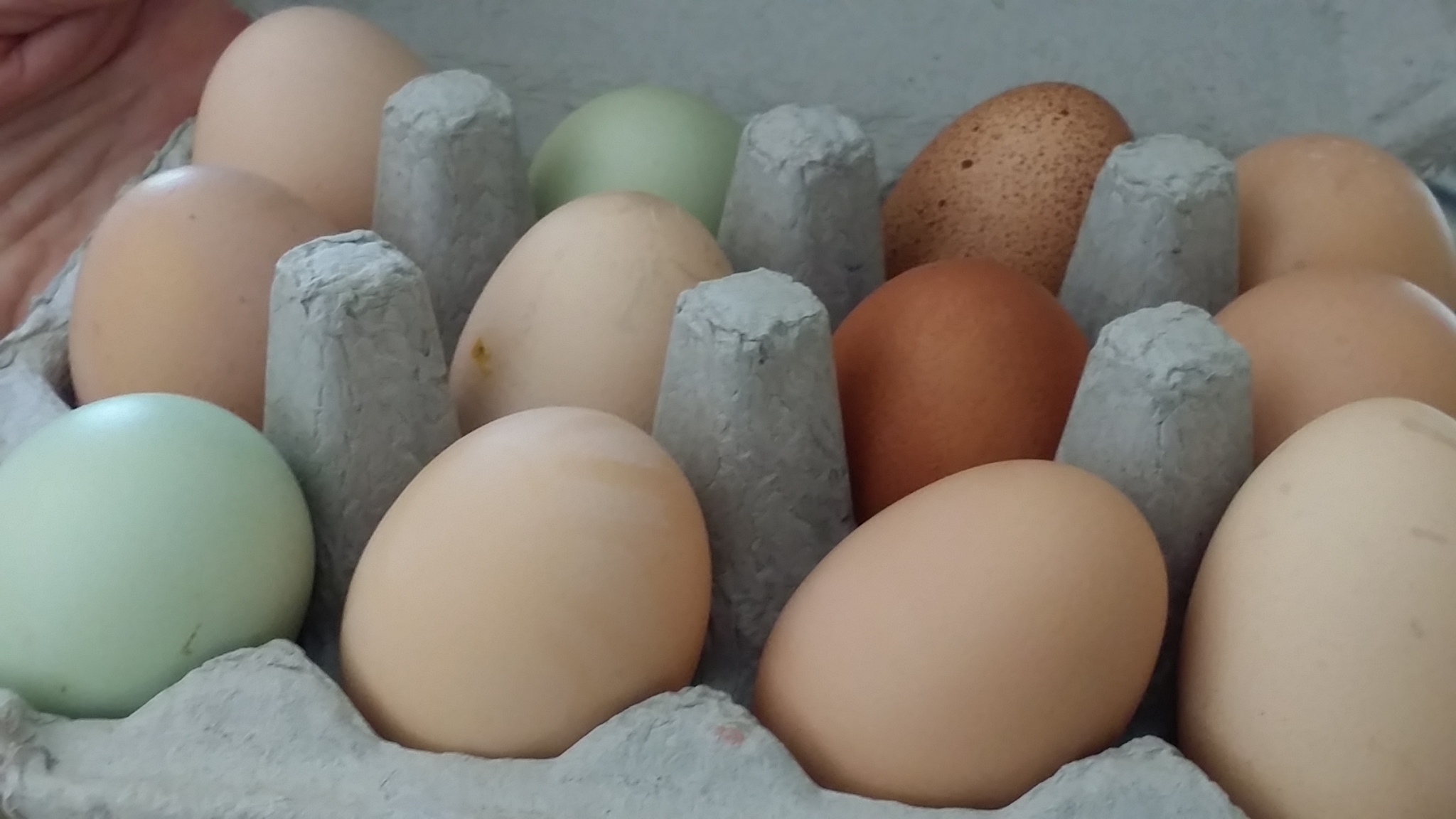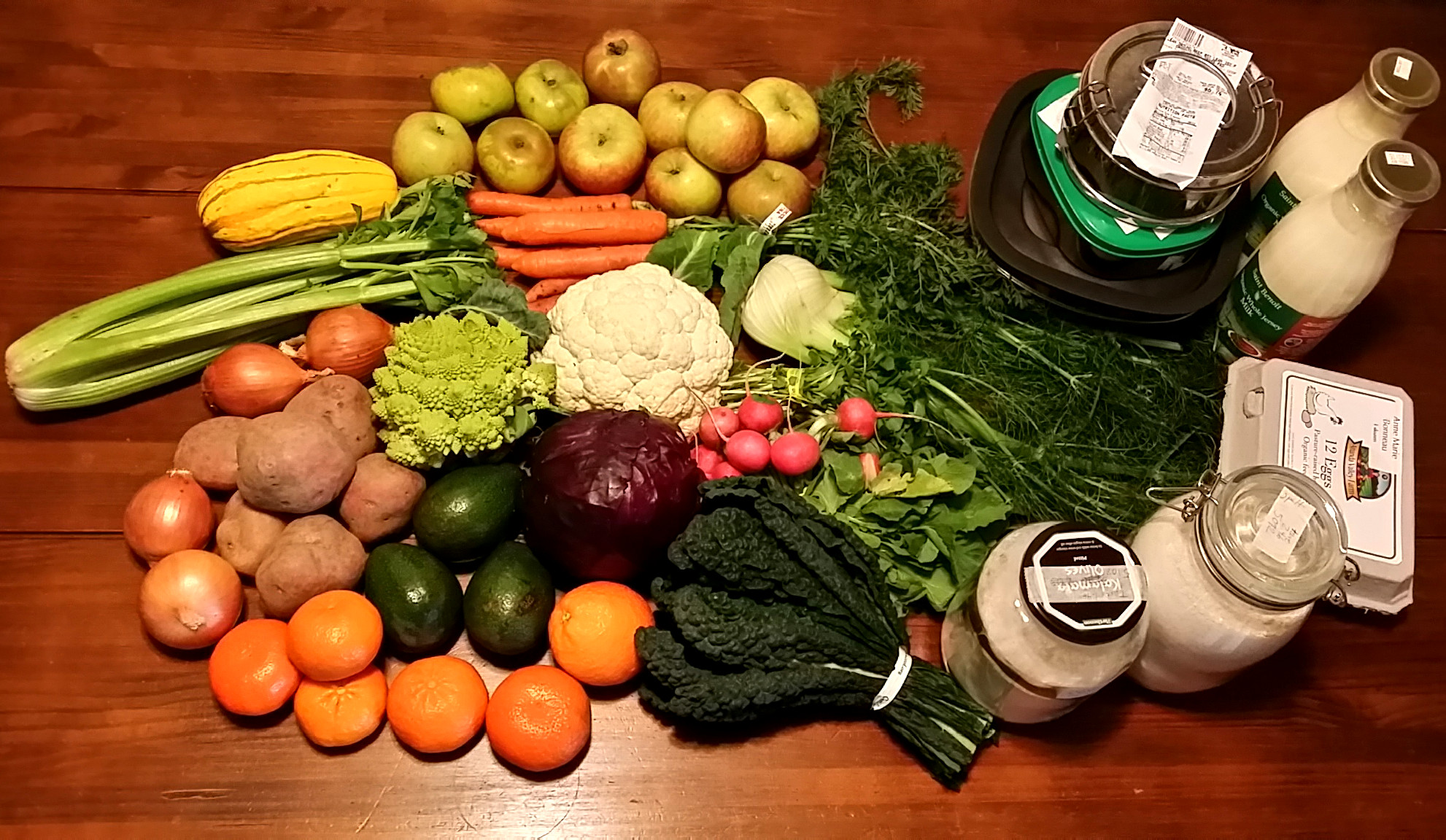
To reduce kitchen waste—and to save time and money—I improvise when I cook rather than strictly follow recipes. If you follow recipes for a different dish every night, in no time, ingredients you bought specifically for those dishes but didn’t use entirely—plus leftovers—will overrun your kitchen. You and your family can eat only so much!
Master some basic cooking techniques, such as making soup, and you won’t need recipes because you’ll know what to do with what you have. You may soon realize you don’t need to buy nearly as much food as you had thought. Having said that, do know that I don’t stock my entire list in my kitchen at once. For example, the produce we eat varies by season however, I always have onions, carrots and celery on hand.
With my plastic-free and zero-waste ingredients (all of which are organic), I can cook an endless variety of meals without generating waste. I am lucky to live within biking distance of three stores with decent bulk bins. On Sundays, Vlad goes to San Francisco and drives right past bulk heaven, aka Rainbow Coop, so I often go with him and shop there. At Rainbow, I can buy not only the usual bulk dry goods but also bulk wet goods such as coconut oil, olive oil, olives, honey, peanut butter and so forth. I buy bulk items in glass jars, metal containers and cloth produce bags.

Farmer’s Market Produce
Vegetables
Onions (yellow, white and red); carrots; celery; radishes; cabbage (purple and green); shallots; leeks; cauliflower; broccoli; green beans; zucchini; squash; potatoes; beets; turnips; parsnips; salad leaves; sweet peppers; hot peppers; eggplant; mushrooms; tomatoes.
Fruit
Apples; oranges; lemons; limes; pears; grapes; peaches; plums; strawberries; raspberries; blueberries; watermelon; cantaloupe; honeydew melon; figs; pomegranates.
Fresh herbs
Garlic; ginger; parsley, cilantro; rosemary; basil; thyme; dill; chives; sage.
Dairy and Eggs
Non-homogenized whole milk; raw milk; half and half; heavy cream; yogurt; unsalted butter; salted butter; pastured eggs.
Fish and Seafood*
Salmon; tilapia; swordfish; shrimp; mussels; scallops.
Meat and Chicken*
Grass-fed ground beef; grass-fed stewing beef; chicken thighs; ground chicken; chicken sausage; pancetta; proscuitto.
Pantry
Olive oil; coconut oil; olives; pickles; capers; soy sauce; raw honey; sea salt; Himalayan salt; tomato paste; tahini paste; peanut butter; anchovies; vinegar (scrap and kombucha); molasses; maple syrup.
Tea and Spices
Black tea; oolong tea; Earl Grey tea; herbal tea; bay leaves; black peppercorns; ginger; cloves; allspice; cardamom pods; whole nutmeg; cinnamon (ground and sticks); oregano; rosemary; dill seeds; mustard seeds; cayenne pepper; crushed red chiles; coriander (ground and seeds); turmeric; cumin (ground and seeds); fennel seeds; fenugreek seeds; amchoor powder; garam masala; paprika; saffron.

Nuts and Seeds
Walnuts; almonds; hazelnuts; pecans; pine nuts; pistachios; sunflower seeds; pumpkin seeds; poppy seeds; chia seeds; hemp seeds.
Dried Fruit
Golden raisins; Thompson raisins; figs; dates, apricots.
Staples
Beans
Black beans; white beans; fava beans; pinto beans; chickpeas; barlotti beans; butter beans; lentils (red, yellow and green).

Pasta
Orecchitte; spaghetti; macaroni; fettucine.
Rice and grains
Basmati rice (white and brown); arborio rice; sushi rice; steel-cut oats; rolled oats; couscous; quinoa; teff; wheat berries; sorghum; bulgur wheat; barley; millet; polenta; buckwheat; flaxseed; popcorn.
Baking Supplies
Whole wheat flour; whole wheat bread flour; white flour; white bread flour; rye flour; spelt flour; pastry flour; corn meal; masa flour; semolina; cane sugar; sucanat; coconut sugar; confectioners’ sugar; light brown sugar; cocoa powder; chocolate chips and morsels; flaked coconut; baking soda; baking powder; cream of tartar; cornstarch; citric acid; vanilla beans; vanilla.
While I do make a lot of staples myself—lard, sour cream, chai, ketchup and so on—I may have forgotten to include a few things here. What did I miss? What can you not live without in your pantry?
*We eat very little meat and fish.

Reblogged this on Mommy Emu and commented:
Ever woundered what basic ingredients you should have in your zero waste kitchen? The Zero waste Chief has all the answers.
Thank you for the reblog!
OMG, I think we might be able to let you off on the one item, the amchoor powder, you have an amazing pantry! What is amchoor powder for anyway?
Thank you! I use amchoor powder in Indian dishes. It’s made out of unripe mangoes for a sour taste. My older daughter LOVES it. It really does add delicious flavor. But I have trouble finding it.
Reblogged this on Jeepers and commented:
This is an amazing resource if you’re looking to stock your pantry while reducing packaging–and eat really well, too!
Thank you for the reblog 🙂
Ohhhh…those pics of the fresh food look sooooooo good! 🙂 We’re getting on towards autumn, and the first bite of cold weather is in the air – seeing the yummy food in your pics makes me keen to make up some bulk lots of soup for the freezer! 🙂
Thank you! Great idea to make and freeze soup. I’ll have to do that this summer. At the end of last summer, over a few weekends, I roasted piles of tomatoes and froze them but we ran out in January. I have to wait a few more months for them to reappear. It’s just starting to warm up here 🙂
Yumm…tomatoes! I grow lots of cherry tomatoes on my deck – five plants this year, and I’m thinking I’ll grow ten next year, as we’ve been eating so many of them. One of my friends has been buying up cheap tomatoes and making home made tomato ketchup and relish, and giving it to me – I might have a go next year and try doing it myself! But what I really want to try is salsa 🙂
Salsa is on my list this summer too. I hope to make a pile of it…and roast more tomatoes too!
How do you check out at whole foods without putting bulk ingredients in plastic?
I use lightweight cloth produce/bulk bags and glass jars for bulk food. Customer service will weigh your jars and mark the “tare” on them. You fill up in at the bulk bins and then when you checkout, the cashier will weigh the jar and deduct the tare, so you pay only for what’s inside the jar. I do keep an eye on the screen when the cashier rings everything up. A few cashiers (not many) have been confused and so I make sure they enter the tare. At Rainbow, the cashiers never fail to do this, they sell so much bulk and know the drill.
Thanks!!
You’re welcome 🙂
Here in Atlanta, it is a challenge to find the things I need in bulk. I find myself shopping at 3 different stores, plus the farmer’s market. I know that in smaller towns, it’s even harder. Luckily, the co-op here carries organic milk in glass bottles, and most staple items in bulk. Just making the effort has really cut down on waste, and saved me a lot of money. Thanks for the excellent blog!
It really does cut down on the trash and it’s easy to do if you have access to stores with good bulk bins. Thanks for checking out my blog and for the comment 🙂
I live not far from Rainbow, and really need to make better use of it! You are inspiring me! I need to get better at planning meals for myself.
Hi Sharon,
I am jealous! I wish I lived closer to Rainbow. I go when I am in the city, which isn’t as often as I’d like. I find meal planning helps, even for a few days in advance. I wrote a blog about that and added a 1-page meal planner you can download if you’re interested: https://zerowastechef.com/2016/11/30/4-step-meal-planning/
~ Anne Marie
Not criticizing in anyway shape or form but is this made to help a zero waster compile her grocery store shopping list? Because I may use it for just that. I usually make my list out of the meals I think of for the week. This makes it a bit easier looking at it from another angle and I love it. Thanks!
Hi Sarah. Yes, it’s supposed to be a running list of staples. I made a meal planner that you can use with it: https://zerowastechef.com/wp-content/uploads/2017/05/fillable_menu_planner.pdf One day I will get around to turning the list in this post into a similar PDF. I have laid it out, I just have to make it fillable and load it into my blog. It’s on the to-do list. I hope the list helps make shopping easier 🙂 ~ Anne Marie